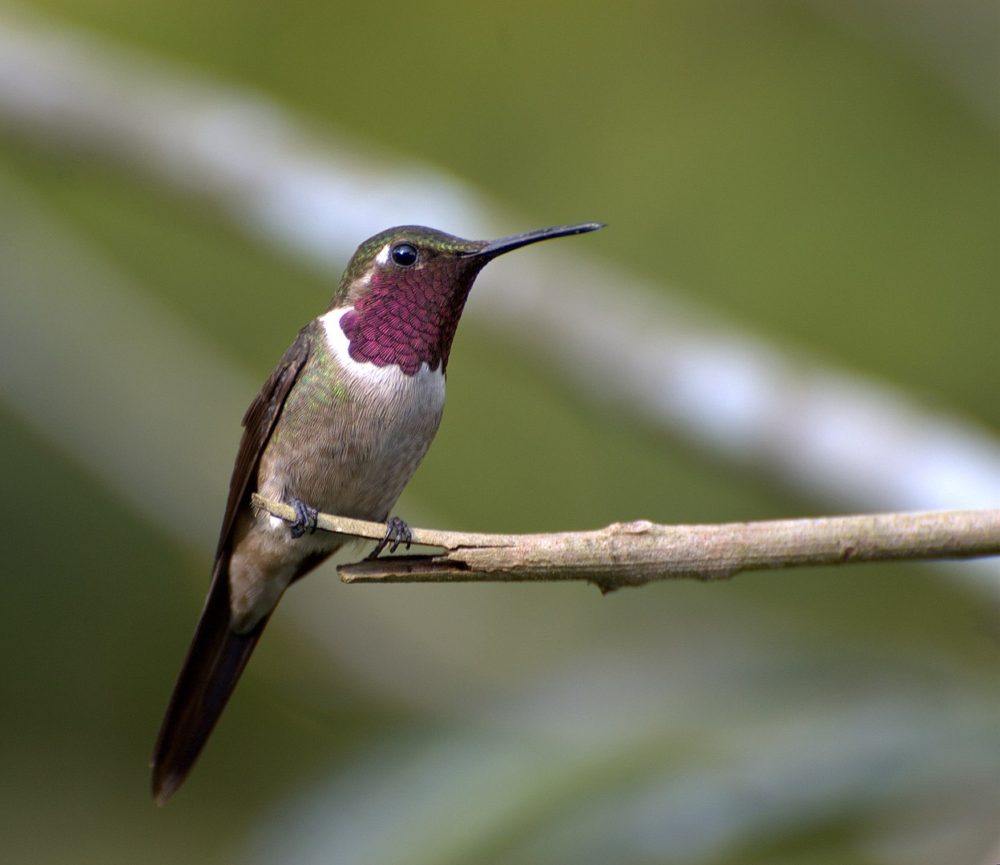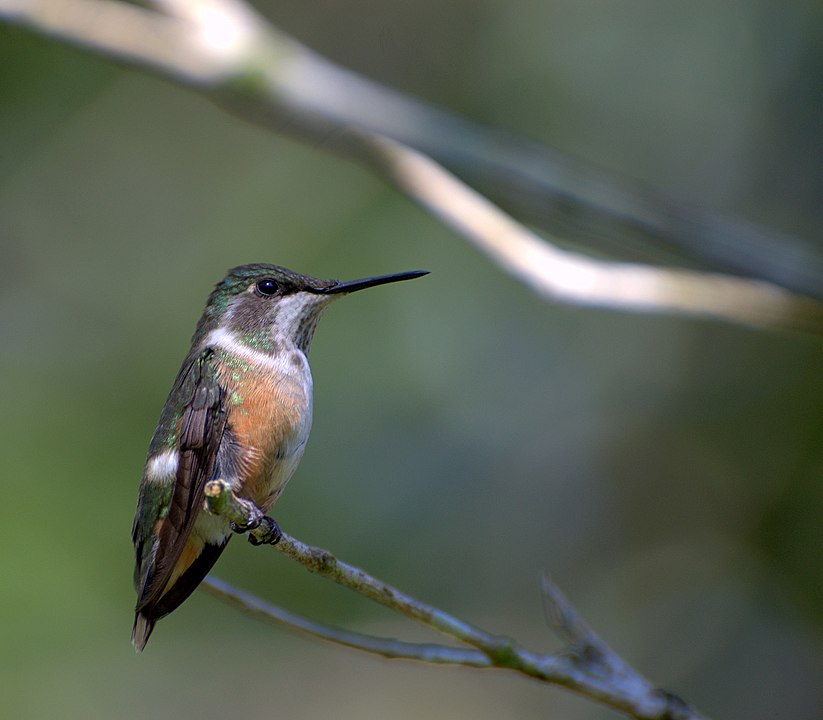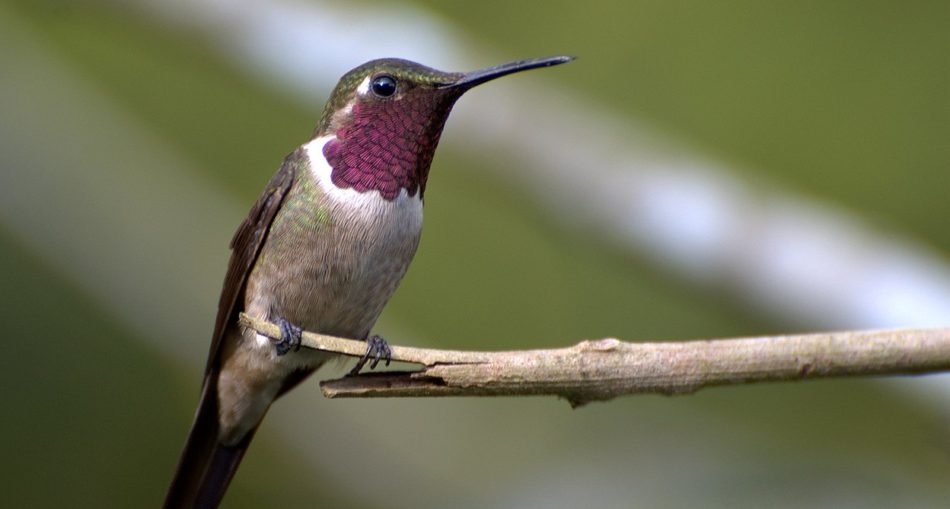The Amethyst Woodstar is one of the smallest hummingbirds found in parts of Central and South America. The tiny bird was named after its glossy, distinctive purple throat which is noticeable as it flutters from flower to flower in search of nectar. The scientific name of the Amethyst Woodstar is Calliphlox amethystina. There is believed to be a hybrid species between the Calliphlox amethystina and Chlorostilbon aureoventris, known as Calliphlox iridescens Gould. The Amethyst Woodstar is native to Guyana, Bolivia, Brazil, Colombia, Ecuador, French Guiana, Suriname, Paraguay, Peru, and Venezuela and can be found in a number of habitats.

The Male Amethyst Woodstar – Photo By Dario Sanches from SÃO PAULO, BRASIL – ESTRELINHA-AMETISTA macho ( Calliphlox amethystina ), CC BY-SA 2.0, https://commons.wikimedia.org/w/index.php?curid=3955046
Description Of The Amethyst Woodstar
The Amethyst Woodstar is among the smallest of hummingbirds reaching about three (3) inches in length with an average weight of three (3) grams. Their wings are short and they have straight black bills. The species is sexually dysmorphic in colour. The male Amethyst Woodstar has a rich, luminous purple or throat, which can look black in unfavourable lighting. They also have a white band stretching across the chest with a deeply forked tail. The female Amethyst Woodstar on the other hand has green dots on the throat, white under plumage and a tail shorter than the male.

The Female Amethyst Woodstar – Photo By Dario Sanches from SÃO PAULO, BRASIL – ESTRELINHA-AMETISTA fêmea ( Calliphlox amethystina ), CC BY-SA 2.0, https://commons.wikimedia.org/w/index.php?curid=3955034
Scientific Classification Of The Amethyst Woodstar
- Kingdom: Animalia
- Phylum: Chordata
- Class: Aves
- Order: Apodiformes
- Family: Trochilidae
- Genus: Calliphlox
- Species: C. amethystina
Habitat Of The Amethyst Woodstar
Native to most of South America, the Amethyst Woodstar lives in a wide variety of habitats including savannahs, woodlands, gardens, forest clearings, tropical and subtropical moist lowland forest or moist montane forests. However, they cannot be found along the Amazon River in the central Amazon Basin or the central upper Basin. The hummingbird can be found in the foothills of the Andes, at higher elevations, especially near upstream rivers and sandy areas in Suriname.
Diet Of The Amethyst Woodstar
Like all hummingbirds, the diet of the Amethyst Woodstar primarily consists of flower nectar but they may eat tiny insects. Their tongues are extremely long and are used to collect the nectar typically from bright, colourful blooms of herbs, shrubs, trees and epiphytes. Their favourite flowers are those with high sugar content, especially those that are tubular and red in colour. Small insects and spiders, caught in flight or grabbed from leaves and branches or captured from spider webs are also consumed.
Reproduction Of The Amethyst Woodstar
The breeding season of the Amethyst Woodstar occurs from November to April. Courting is done by the males who fly in a u-shaped pattern in front of the females. Either gender will mate with a number of other birds of the same species. The female Amethyst Woodstar usually nests in shrubs, bushes or trees. The bird builds its nest of plant fibre and moss in a cup-shape, lining it with soft plant matter, feather down and animal hair. Male Amethyst Woodstars take no part in the care of the young or nest-building and leave after mating.
The females lay a clutch with about one to three (1-3) white eggs and incubate them for about two weeks. At birth, young Amethyst Woodstars are blind, immobile and lack down. The chicks are protected by the female who feeds them regurgitated food, typically insects because of their nutrient content. With her long bill, she pushes the partially-digested insects down their throats and into their stomach. The chicks are brooded for as long as two (2) weeks, then left alone for about twelve (12) days. At about twenty to twenty-two (20-22) days old the chicks are ready to leave the nest.
10 Facts About The Amethyst Woodstar
- Being approximately three (3) inches in height and three (3) grams in weight, the Amethyst Woodstar ranks among the smallest birds in the world.
- Though relatively tiny, the Amethyst Woodstar protect areas where its favourite flowers grow i.e. those with high energy nectar.
- The males especially are hostile to other males and insects that enter their established feeding territories, using aerial flights and intimidating displays.
- The Amethyst Woodstar catches insects via hawking; they capture them from branches or leaves, or spiderwebs.
- The long tongue of the Amethyst Woodstar is efficient at extracting nectar from tubular flowers.
- While they live in a wide variety of habitats, the birds tend to steer clear from forest interiors.
- They can lick nectar from a flower for as much as thirteen (13) times per second.
- The Amethyst Woodstar is a solitary species that do not live or migrate in flocks with no pair bond existing.
- A nesting female Amethyst Woodstar can catch a whopping two thousand (2000) insects per day.
- The female makes the nest with spider webbing and sticky material which allows the nest to stretch to accommodate the growing chicks.
About The Amethyst Woodstar
The Amethyst Woodstar, a purple throated hummingbird is one of the tiniest birds to exist. They are especially important in the pollination of tubular flowers. The unique shape of the flowers only allows the hummingbird to pollinate it via feeding. The Amethyst Woodstar is a rare sight but can be spotted near local hummingbird feeders or birdbaths.
Article Reference
- http://www.arthurgrosset.com/sabirds/amethystwoodstar.html#:~:text=The%20fact%20that%20the%20photos,small%20and%20with%20short%20wings.
- https://www.beautyofbirds.com/amethystwoodstars.html
- https://en.wikipedia.org/wiki/Amethyst_woodstar







